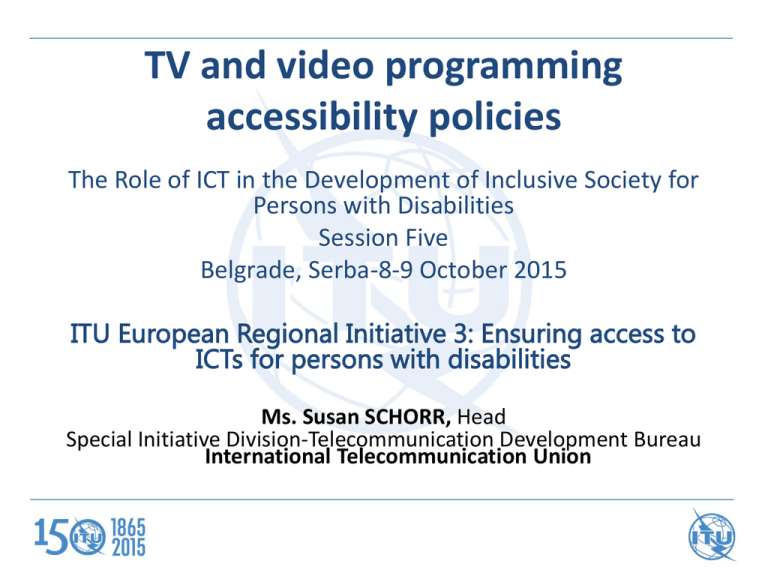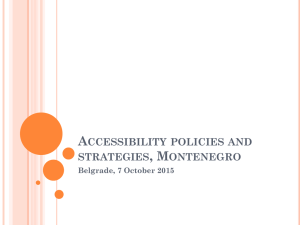TV and video programming accessibility policies
advertisement

TV and video programming accessibility policies The Role of ICT in the Development of Inclusive Society for Persons with Disabilities Session Five Belgrade, Serba-8-9 October 2015 ITU European Regional Initiative 3: Ensuring access to ICTs for persons with disabilities Ms. Susan SCHORR, Head Special Initiative Division-Telecommunication Development Bureau International Telecommunication Union ICT Accessibility in the United Nations Convention on the Rights of Persons with Disabilities - CRPD • Article 30 of the CRPD requires State Parties to “take all appropriate measures to ensure that Persons with Disabilities . . . enjoy access to television programmes [and] films . . . in accessible formats.” 2 Model ICT Accessibility Policy Report: Module 4: TV/Video Programming Accessibility What do we mean? terminology • Recognizes that some countries have not yet migrated to digital tv or may have regulatory frameworks that only use terms like “tv” or “broadcasting” • Also recognizes the world is rapidly going digital, using a variety of platforms, so it also uses the term “video programming” as a more generic term. Countries of course are free to select their own terms • The model policy was written to apply to all forms of video programming whether traditional, IPTV, IBB, HBB and also applies to EPGs, remote control and TV devices • Regulates licensed service providers (LSPs) Goals of the model policy To ensure policy makers consult with persons with disabilities in developing the policy Licensed service providers deliver AD, audio subtitles (where appropriate), CC and signing Raise awareness the policy exists; raise awareness when access services are available Train customer service staff on how to serve customers with disabilities Train staff to show customers how they can find info about access services on EPGs and customize available access services Adopt quality of service standards for access services Goals of the model policy EPGs use internationally recognized access service icons Adopt technical standards for interoperable TV/video programming services so users can receive, decode and display access services Emergency information and public safety announcements use access services Provide adequate funding to public broadcasters to enable them to provide access services Establish targets and reporting requirements for delivery of access services Adapt and develop a roadmap Regulator defines in regulations, license conditions, codes of good practices steps for progressive implementation of access services • together with licensed service providers and organizations of persons with disabilities a roadmap Prioritize implementation for different types of programmes (news, live, emergency, pre-recorded • Targets may differ by type of licensed service providers • E.g. public broadcasters who receive funding for content development may have greater responsibilities than commercial service providers Closed captions - In Closed captions preferable to open captions at least one official language - In the language of the audio portion - Include sound representations NRA to establish minimum levels of quality or maximum error rates - to assure comprehensibility and synchronization with video Develop rules in consultation with all stakeholders, including DPOs Audio description In the official language(s) of the country AD language should be same as the programme audio Foreign language programmes to include audio subtitles + AD LSPs who create video programming to ensure that producers, editors and presenters are trained to audio describe and report on their training in an annual report to the NRA Quality of service • NRA to determine them in consultation with stakeholders, including DPOs • Captions are readable, accurate and comprehensible – Specify font type, size, contrast and use of colors and requirements on viewer control over these – Maximum error rates and synchronization with dialogue • Placement and clarity of AD Establish targets and annual report Percentage and type of programming with AD & CC QoS standards for accuracy and synchronization Accessible emergency announcements Awareness steps Use of icons on EPGs Periodic review • TV/video programming is changing rapidly • Need for policy and regulatory review to address new issues and new players Explains, in concrete terms, what we mean by accessible mobile phones Developments in accessible mobile apps Business opportunities and case studies Policy guidelines http://www.itu.int/en/ITU-D/Digital-Inclusion/Pages/Reports.aspx : Thank you for your attention! For more information: • www.itu.int/en/ITU-D/Digital-Inclusion/ • www.itu.int/accessibility • susan.schorr@itu.int 13

